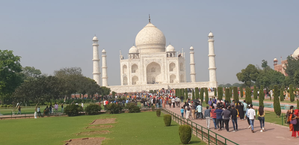Agra: Ahead of World Environment Day on June 5, the stark reality of Agra’s environmental crisis has come into sharp focus.
Despite the Supreme Court’s 1993 intervention on the petition by MC Mehta, to protect the Taj Mahal and other heritage sites in the Taj Trapezium Zone (TTZ), the ecological situation has deteriorated dramatically.
The diminishing green cover and severely polluted water bodies present a grim picture of the collective failure to tackle the alarming ecological issues in this eco-sensitive region, which spans over 10,480 square kilometers.
Local environmentalists warn, “Air and water pollution continue to threaten the Taj Mahal. The battle against pollution has been lost due to a lack of commitment and willpower at the highest levels of governance.”
The effects of air pollution are now evident in the consistently rising temperatures, says Eco Club president Pradip.
In 1993, the Supreme Court mandated a series of measures based on the high-powered S. Vardarajan committee’s recommendations to combat pollution threatening the Taj Mahal. Despite spending thousands of crores of rupees, the environmental situation in the TTZ remains dire.
Agra’s air quality has deteriorated significantly, with the city performing poorly on the air quality index year after year. Dust levels (SPM and RSPM) and noxious gases in the ambient air pose serious threats to both human health and historical monuments. Despite the city’s participation in the Smart City initiative, the results fail to inspire confidence in achieving eco-equilibrium.
Agra’s green cover has plummeted to less than six per cent, far below the national target of 33 per cent. The SPM level exceeds 350 micrograms per cubic meter, soaring above 600 in the summer, against a standard of 100 micrograms. The rise in noxious gases is exacerbated by a boom in automobile numbers – from 40,000 in the early 1980s to over a million today in the Agra district alone.
The severely polluted Yamuna River, now virtually dry, is a major pollution source.
Social activist Rajiv Gupta of Lok Swar laments, “The Yamuna’s dry bed and polluted waters pose serious threats to historical monuments along its banks. Despite decades of judicial activism and significant investments, Agra remains littered with garbage, and pollution levels threaten both people and monuments.”
Illegal stone mining in the Aravali ranges and malfunctioning sewage treatment plants (STPs) compound the problem. Most of Agra’s sewage is discharged untreated into the Yamuna, further degrading the river’s health. The city’s four treatment plants cannot process all the waste and sewer produced daily.
Though the Supreme Court in 1996 ordered the planting of trees on Agra’s western periphery to combat dust-laden winds from Rajasthan, greenery has vanished, replaced by tall buildings where community ponds once existed. The unchecked urban sprawl, encroachment on parks, and illegal structures overshadowing historical sites reflect the chaos of unplanned urbanisation.
Environmentalists warn that the battle against pollution in the TTZ has been lost even before it truly began.
Local environmentalists are now demanding a comprehensive review of past actions and a detailed white paper on the expenditures and outcomes. Despite continuous monitoring by the Supreme Court and the National Green Tribunal (NGT), the environmental situation in the Taj Trapezium Zone remains critical.
Activists describe Yamuna River in Agra as virtually dead due to its dry riverbed and heavily polluted waters, which pose serious threats to historical monuments.
“The Supreme Court’s directive to plant rows of trees along the city’s western periphery to filter dust-laden winds from Rajasthan has not been implemented. Instead, tall buildings have replaced green spaces and community ponds, with illegal structures overshadowing historical monuments,” complained green activist Devashish Bhattacharya.
–IANS


Comments are closed.